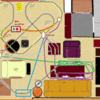Here's a simple method for controlling two trains on the same track that was published in PS 1962. The pictures illustrate pretty clearly how it works. Whistle tenders will obviously need to be disconnected or they will sound continuously. Space inside your loco will need to be allocated for a single diode to compliment the supply diode.
Each train will respond to its own throttle in this system!
That circuit may independently control two trains but in addition to requiring modifications to your engines and whistle/horn units, it won’t do what the OP wants to do which he stated in his 2nd posting above “I would like to run two trains on the same loop automatically stopping and starting the trains”. The key word is “automatically”.
So it’s back to the “old school” such as Choo Choo Charlie’s layout or by following the diagrams in the post-war operating manuals like that 1965 manual posted above (BTW to rtr12: that is a scan of my copy which I had posted a year or so ago).
I noticed that Charlie used 12-volt AC relays which simplifies the circuit and wiring. When building a previous layout many years ago I got lucky and found some 12-volt AC DPDT relays at a local electronic surplus store which I’m still using. They don’t carry them any longer. I’m sure Arthur Bloom and the other “older” telephone guys are familiar with those relays!
And Charlie added a useful extra twist to allow operation in either direction.
Bill
Thanks, I have noted proper credit so I get it correct next time. I used to be able to remember these things. ![]()
Automation Direct has 12 volt AC relays in SPDT, DPST, 3PDT & 4PDT. Linking to the relays here has failed in the past, but if you got to their site and drill down through the menus to the General Purpose, 15A, (781/782/783/784 series you will find them. Lots of nice features as well. Sockets are available also (links from the relay pages).
The menus would be:
Relays / Timers > Electro-Mechanical Relays > Square / Cube Relays... > General Purpose, 15A (781 / 782 / 783 / 784 Series)













